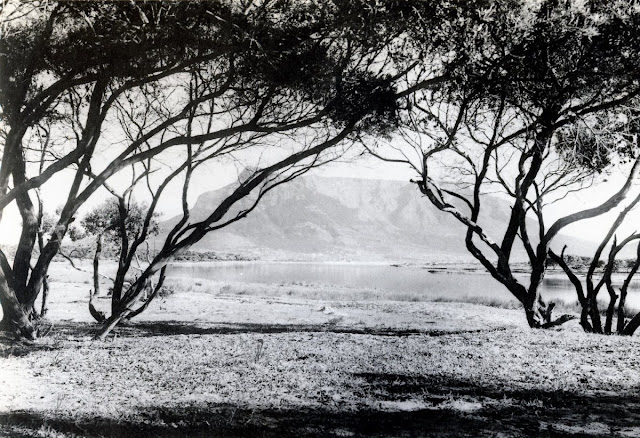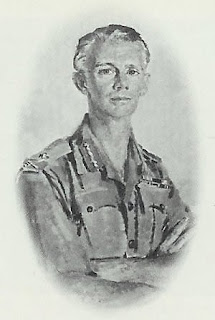The Township becomes a Town
On 5 April 1906, 200 sightseers were taken to
Milnerton by special train and “expressed themselves as surprised at both the
development that has taken place and the natural beauty and charm of the
Estate”.
 |
| Milnerton c. 1905 |
Despite this evidence of goodwill towards the new
township, the continuance of the Slump could not be ignored and led during 1906
to the introduction of a new sales technique which, the management hoped, would
help to neutralise the prevailing financial stagnation. This was described as
“Sales of Land by means of Travellers”, who today would be described as
itinerant salesmen. According to the instructions given, these emissaries were
to travel round Cape Colony, quoting £100 for inside lots, £130 for corner and
shop lots, and £150 for corner shop lots. Considerable success seems to have
attended this experiment, with almost 40 lots sold in this manner by the end of
the year. By the end of 1908, 15 miles of gravel road had been laid on the
Estate and 30,000 trees had been planted. By August 1910, with a new team of
travelling agents at work, 17 further plots had been sold. Prices ranged from
£90 to £500, the customers coming from Cape Town, Vereeniging, Kroonstad, Lady
Grey, Barkly East, Adelaide, Kimberley, to say nothing of Cape Town itself.
Development of a permanent community at Milnerton now took place at an
increasing rate.
Donaldson & Braby’s Cape Directory for
1912/13 gives a crisp account of Milnerton, describing it as “a rising
residential suburb, five and a half miles by rail from the Metropolis. Then
follows a list of residents, namely: F. Botha, T. Gallagher, W. Cason, J.H.
Cooper, C. Craig, D. Gunn, W. Langerman, W. Mathews, D. Panton (Proprietor of
Hotel), J. G. Reid and Mrs Steyn. This list, though not comprehensive, provides
an important record of some of Milnerton’s first residents.
In an entry the following year, A. van Niekerk of
Vissers Hoek was recorded as being both the Field Cornet and Justice of the
Peace, and Dr R. Sharp the District Surgeon. Already the number of residents
had shot up to over 50, a figure raised to 54 in 1914.
Political
influence available to the management of Milnerton received a fresh boost in
1915 through the election of Sir David Pieter de Villiers Graaff as Chairman of
Milnerton Estates. He was one of the most important personalities in public
life at the Cape. Besides being a close neighbour, on his famous farm De
Grendel, Sir David was Chairman of the Imperial Cold Storage & Supply
Company Limited, and a member of the Union Cabinet, first as Minister of Public
Works, then as Minister without Portfolio, and later as Minister of Finance and
of Posts and Telegraphs. In 1929, he purchased land on what is now called
Woodbridge Island and had his impressive mansion Zonnekus built there. The Sir Herbert Baker designed homestead blends Spanish colonial
and Cape Dutch architecture.
 |
| Sir David Pieter de Villiers Graaff |
 |
| The Graaff family home, Zonnekus |
Notwithstanding the upheaval caused by the First
World War, some development still took place. In 1916, ownership of the
Cambridge Hotel passed to F. W. Glover, while there were two new dairy
proprietors, G. Cloete and G. Griffiths; also J. Pentz, blacksmith; and J.
Succa, crayfish factory.
The abnormal times did not prevent an “Electric
Light Agreement” being signed in 1917, under which a power line was run from
Cape Town to the residential areas, collection of accounts being left to the
Company.
Though still very tiny, Milnerton was already in
1922 assuming the outlines of a community. Following the recent completion of
the Steenbras Water Scheme, Cape Town was in a position to improve both the
quantity and quality of its supplies to Milnerton, through a new main pipeline
on Koeberg Road.
For the first time, the 1926 census provided
official and separate figures regarding Milnerton’s population, giving 247
Europeans, of whom 107 were listed in the Directory.
Recognition of Milnerton’s emergence as a suburb
came with the establishment of the Milnerton Local Board, with effect from 31
December 1926. For the first time, too, there was mention of a Ratepayers’
Association, which held a meeting in June 1931.
Fortunately,
the Depression came to a sudden end at the end of 1932, when South Africa’s
departure from the Gold Standard brought an enormous increase in mining
revenue, and with it not only a boom on the share market, but a vast influx of
capital. Once again, there was plenty of money available for mortgages, while
people, back in jobs, were eager to buy houses. New residents recorded in 1934
were: W. S. Caw, plumber; S. Harris, carpenter; and F. Botha, the Secretary of
the Milnerton Turf Club.
It was not
long before a controversy arose about street names. The original proposal was
that roads should be called after old Cape Commanders and Governors, but in
1937 this proposal was replaced by one substituting South African place names,
particularly those in the Cape Province. In a stroke of genius, the streets
were named alphabetically, beginning with Algoa Road and ending with Zastron
Road, thereby greatly assisting visitors to the suburb. The same principle was
later applied to Milnerton North, but using the names of flowering plants and
trees.
At the
height of the Second World War, Major-General Frank Theron became a landowner,
when he purchased Lots Nos. 137 and 138 in Milnerton Extension No. 1, for the
sum of £414. Several years were still to pass, however, before this famous
military leader could fulfill his ambition to retire to his lovely home
overlooking the lagoon. I vividly recall the occasion that he invited our
family to lunch at his home. While we normally enjoyed a Sunday roast at home,
we could afford only one chicken to feed six. Imagine our surprise when each of
us was handed an entire chicken – well, a bantam, to be precise. Sadly,
Major-General Theron passed away shortly afterwards, in August 1967.
 |
| Major-General Frank Theron |
 |
| Major-General Theron's former home, now the Lagoon Lodge Guest House |
Only a few days after the end of the war, Milnerton
received a tacit tribute to its importance when Major JC Collings, Government
Director of Housing, telephoned asking for an urgent meeting to discuss the
matter of houses for ex-servicemen. Milnerton Estates regarded this as a
compliment and, after consultation, agreed to provide 100 lots for 50 houses
“for superior types of South Africans, who will be desirable residents in a
good class residential area, each such house to be on two lots”. Thenceforth
the scheme was put into effect. By 28 June 1946, ten of these houses had
already been built or were under construction.
This additional influx of population was
accompanied by a spurt in business, enquiries being received for the erection,
on a rental basis by the Company, of a garage, a cafe, a grocer’s shop, a
chemist shop and a butcher’s shop, in what was, strictly speaking, a
residential area. The Government purchased two lots on Koeberg Road (between
Dordrecht and Ceres Roads) for the erection of a Police Station, while the
sense of civic spirit was stimulated by the setting up of a Ratepayers’
Association in August 1946.
A striking tribute to the charms of Milnerton was
furnished in 1951 when the former Governor-General of South Africa, Major
Gideon Brand Van Zyl, took possession of Cotswold House, designed in 1947 in
the old Cape Dutch style. Here he spent the next five years, until his death in
1956, and here his widow remained until she too passed away in 1973.
 |
| Major Gideon Brand van Zyl |
 |
| Major van Zyl's former home, now the Cotswold Guest House |
Another sign of the
growing community spirit was the formation, on 29 June 1951, of a Civic
Association.
It was announced on 29
June 1953 that the Milnerton Local Board was actively engaged in the
preparation of a scheme to provide main drainage facilities for the village. In
1957, work began on the provision of sewerage, estimated to cost the then
gigantic sum of £250,000. In 1958, arrangements were completed for the outfall
on the farm Potsdam. Within another 12 months this amenity was in operation,
the expenditure having reached £290,000.
As from 1 July 1955, the
Milnerton Local Board made way for the Municipality of Milnerton, with six
councillors. The tender for constructing the first section of the Municipal
Offices was awarded to Beekman & Theunisen (Pty) Ltd. at R165,000. Roof-wetting
took place on 25 February 1966 and five months later, on 20 July, came the
formal inauguration.
 |
| The Milnerton Municipality Offices |
Spectacular progress in
the physical growth of Milnerton in these years is brought home by the remark
of the Mayor, who indicated that during 1966 and 1967 the Municipal valuation
had risen from R12 million to R27 million, a spurt rarely, if ever, equalled in
the history of South Africa.
 |
| The Centre Point Shopping Centre |
|
|
Out
of all these town-planning discussions arose the possibility of erecting tower
blocks. On the site of the house where the Langermans had lived, at the corner
of Loxton and Ascot Roads, there now arose Milnerton’s first high-rise block of
flats, Arnhem, consisting of 10 floors, and it was destined soon to be followed
by others.
 |
| The blocks of flats, seen from the lagoon |
Milnerton
had now emerged as not just a dormitory suburb of Metropolitan Cape Town, but a
town in its own right, independent and self-supporting, with its own viable
industrial and commercial areas and its own economic base.
Statistical
proof of Milnerton’s rapid progress was furnished in September 1974, when it
was made known that, of its original 1,110 plots, only 10 remained vacant.
The official population statistics for the Milnerton
Municipal Area are as follows:
1960 3,166
1970 12,020
1980 23,550
1990 50,500
1994 61,589
The figures from 1960
to 1990 exclude ‘coloureds’ and Blacks who were not property owners or renters
within the area. In January 1994, the Municipality estimated that this excluded
category comprised 2,700 ‘coloureds’, mostly domestic workers and their
families, and about 5,000 Blacks, the majority of whom resided in the Marconi
Beam informal settlement. The 1994 figure therefore includes all races.
In
analysing these statistics, it is important to bear in mind that in 1962 and
1965, first the suburb of Table View and then Bothasig were incorporated into
the Milnerton Municipal Area. During the 1980s, Table View grew rapidly,
becoming the most populous suburb in the area.
As
part of the post-1994 reforms, municipal government experienced a complete
overhaul. In 1996, the Cape Town metropolitan area was divided into six new
municipalities – Cape Town/Central, Tygerberg, South Peninsula, Blaauwberg, Oostenberg,
and Helderberg – along with a Metropolitan Administration to oversee
the whole metropolitan area. As a result, Milnerton Municipality ceased to
exist.
In
2000, these various structures were merged to form the City of Cape Town
as a single metropolitan municipality governing the whole metropolitan
area. It is for this reason that the City of Cape Town is sometimes referred to
as the “Unicity”.
(Once again, I thank the late Eric Rosenthal, who wrote the first official history of Milnerton, for most of the information above. - Ed.)
(Once again, I thank the late Eric Rosenthal, who wrote the first official history of Milnerton, for most of the information above. - Ed.)





Comments
Post a Comment